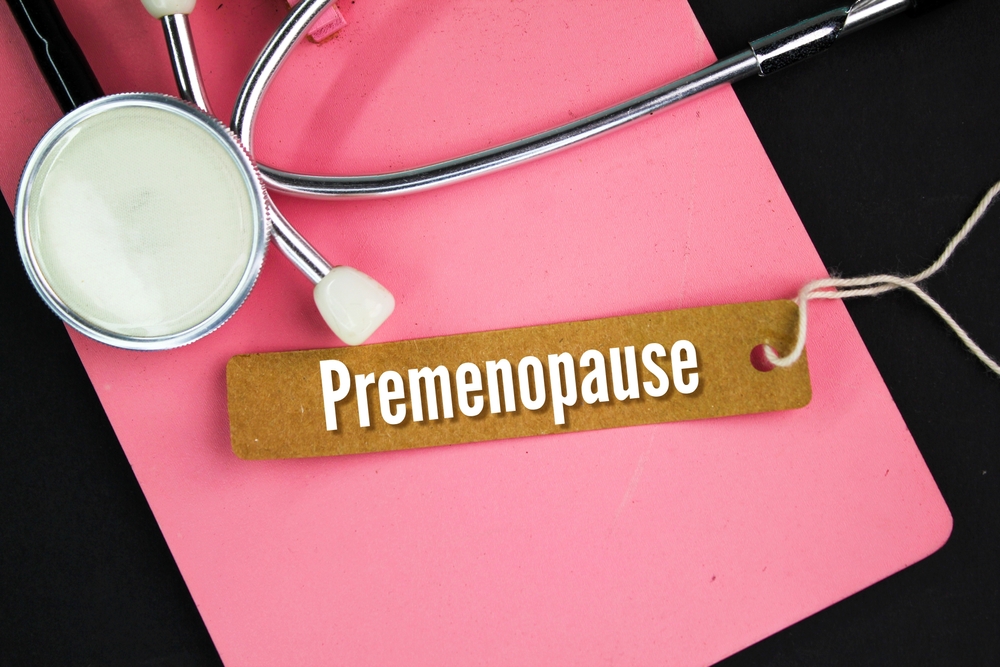The signs of premenopause often appear when you least expect them. Your period changes, your patience runs thin, and you start to wonder if it is stress or something deeper.
Premenopause is the natural phase in a woman's hormonal journey that encompasses the reproductive years before any menopausal symptoms begin. During this time, estrogen remains relatively stable, while progesterone, testosterone, and thyroid hormones gradually decline.
This premenopause is from menarche (a young woman's first period) til perimenopause (typically late 40s to early 50s) and this is the time that a woman will be cycling.
Though these changes are subtle, they can contribute to fatigue, mood swings, and challenges with weight management. Understanding the signs of premenopause can help women navigate this phase with confidence and proactive self-care.
Hormonal/female issues that can occur at this time or be prevalent during this time are PCOS, PMS, Irregular periods, PMDD, etc.
In this article, we'll explore the key signs of premenopause, how hormonal shifts may affect your body, and practical ways to maintain overall well-being during this stage of life.

What Is Premenopause?
Premenopause refers to the reproductive years, from the onset of menstruation at approximately age 12, through the years before perimenopause begins.
Unlike perimenopause, the stage before menopause which is characterized by significant estrogen fluctuations and irregular periods, premenopause is marked by hormonal stability, with only gradual declines in certain hormones over time.
Who Is In The Premenopause Stage?
Every woman who has reached puberty but has not yet entered perimenopause is in the premenopause stage. This means that most women in their teens, 20s and 30s, and sometimes even their early 40s, fall within this category.
During this stage, women experience regular menstrual cycles, and their reproductive system functions normally. However, as they approach their late 30s or early 40s, subtle hormonal changes may begin, signaling the eventual transition toward perimenopause.
Premenopause vs. Perimenopause And Menopause
It is important to distinguish between premenopause, perimenopause, and menopause:
- Premenopause: The stage from puberty until the beginning of hormonal fluctuations that lead to menopause. During premenopause, estrogen levels remain relatively predictable and fluctuate in a cyclical fashion along with progesterone.
- Perimenopause: The transition phase leading up to menopause, during which estrogen begins to fluctuate significantly, causing noticeable symptoms such as irregular periods, hot flashes, night sweats and mood swings.
- Menopause: Defined as 12 consecutive months without a menstrual period. At this stage, estrogen levels remain low, and menstruation ceases permanently.
Recognizing the differences between these three stages can help women better understand their bodies and prepare for the eventual transition into perimenopause and menopause.
Key Signs And Symptoms Of Premenopause
Although premenopause is generally stable, subtle hormonal changes can still have an impact on overall well-being. Even in premenopause there can issues that are related to hormones and hormonal changes. Here are some of the most common signs of premenopause:
1. Fatigue And Low Energy
As progesterone and testosterone levels begin to gradually decline, some women may experience persistent fatigue or lower energy levels. This can make it harder to stay active and maintain motivation throughout the day.
2. Mood Swings And Emotional Changes
Estrogen is still cyclical in this time but it is predictable. Fluctuations in other hormones like progesterone and hormones can contribute to mood swings, irritability, or increased sensitivity to stress. Some women may also experience mild anxiety or depressive feelings during this stage. Remember high school and the teenage years?
3. Subtle Metabolic Changes And Weight Management Challenges
As progesterone and testosterone levels decline, metabolism may slow slightly. This makes it easier to gain weight, particularly around the midsection as well as thyroid. Maintaining a healthy diet and staying active can help counteract these changes.
4. Changes In Sleep Patterns
Though not as severe as the sleep disturbances seen in perimenopause, some women in premenopause may notice difficulty falling asleep or feeling fully rested in the morning. These changes can be influenced by progesterone levels, which help regulate sleep cycles.
5. Mild Changes In Menstrual Flow
While menstrual cycles remain regular during premenopause, some women may notice that their periods become slightly heavier or lighter over time. These shifts are generally minor and do not indicate the onset of perimenopause.
6. Decreased Libido
Lower levels of testosterone and thyroid can result in a reduced sex drive for some women. The gradual decline of other hormones may contribute to changes in sexual desire and responsiveness.
7. Skin And Hair Changes
Hormonal shifts in premenopause may cause subtle changes in the skin and hair. Some women experience drier skin, increased acne, or mild hair thinning. These changes are often linked to a decline in testosterone and thyroid function.
8. Joint And Muscle Aches
Some women begin to experience mild joint stiffness or muscle aches as their hormone levels shift. This can be due to changes in estrogen and progesterone, which play a role in maintaining joint and muscle health. The thyroid and testosterone can have an impact as well.
An Important Reminder
Though this rather long list of symptoms can appear daunting or intimidating, it's important to remember that premenopause remains a relatively stable time in a woman's life.
Symptoms such as muscle aches, decreased libido, low energy, and changes in sleep pattern don't affect women all the time. Rather, they are temporary or cyclical responses to the fluctuating hormones that characterize a woman's reproductive years.
How To Support Your Well-Being During Premenopause
Even though premenopause does not involve drastic hormonal shifts, small lifestyle adjustments can help maintain balance and promote long-term health. Being proactive about your health during this stage can set the foundation for a smoother transition into perimenopause and menopause later in life.
Here are a few helpful strategies to support your well-being during premenopause:
1. Prioritize Nutrition
A well-balanced diet plays a big part in maintaining hormonal balance and overall health. Focus on consuming a variety of nutrient-dense foods that support energy levels, metabolism, and hormone regulation.
- Protein: Lean sources such as chicken, fish, beans, and tofu provide essential amino acids for muscle maintenance and overall health.
- Healthy Fats: Avocados, nuts, seeds, and olive oil support hormone production and brain function.
- Fiber-Rich Foods: Whole grains, fruits, and vegetables aid digestion, stabilize blood sugar levels, and promote gut health.
- Hydration: Drinking at least eight glasses of water daily can help with digestion, skin health, and energy levels.
2. Stay Active
Regular physical activity is practically required for maintaining metabolism, muscle mass, cardiovascular health, and mental well-being. Incorporate a mix of different exercises into your routine:
- Cardiovascular Exercise: Activities like walking, jogging, cycling, and swimming help support heart health and endurance.
- Strength Training: Weight-bearing exercises improve bone density and muscle tone, helping to counteract age-related muscle loss.
- Flexibility and Mobility Work: Yoga, Pilates, and stretching exercises enhance flexibility, balance, and stress relief.
- Consistency is Key: Aim for at least 150 minutes of moderate-intensity exercise per week for overall health benefits.
3. Support Sleep Health
Quality sleep helps maintain hormonal balance, energy levels, and cognitive function. If you struggle with falling or staying asleep, consider the following strategies:
- Establish a Routine: Go to bed and wake up at the same time each day to regulate your circadian rhythm.
- Limit Screen Time: Avoid blue light exposure from phones, tablets, and TVs at least an hour before bedtime.
- Create a Relaxing Environment: Keep your bedroom cool, dark, and quiet to enhance sleep quality.
- Mindful Evening Habits: Reading, journaling, deep breathing, or meditative practices can help signal your body that it's time to rest. Avoid artificial ambient light.
- Avoid Stimulants: Reduce caffeine, alcohol, and heavy meals in the evening to prevent sleep disruptions.
4. Manage Stress
Chronic stress can negatively impact hormone levels, metabolism, and overall well-being. Practicing stress-reducing techniques can improve mental and emotional health. Here are a few tips:
- Mindfulness Practices: Meditation, deep breathing, and guided visualization can help lower cortisol levels and promote relaxation.
- Time for Yourself: Engage in hobbies and activities that bring joy, such as gardening, crafting, or reading.
- Social Connection: Spending time with supportive friends and family can improve emotional resilience and overall happiness.
- Therapy and Counseling: If stress becomes overwhelming, seeking professional help can provide effective coping strategies.
5. Regular Health Checkups
A doctor you see regularly can help monitor hormonal balance and identify any underlying health conditions early.
- Hormonal Testing: Ask your doctor to check levels of estrogen, progesterone, testosterone, and thyroid function if you experience symptoms.
- Annual Exams: Regular screenings, including Pap smears, mammograms, and bone density tests, are important for long-term health.
- Blood Sugar and Cholesterol Checks: Monitoring metabolic health can help prevent diabetes and cardiovascular diseases.
- Supplements as Needed: Based on lab results, your doctor may recommend vitamins such as vitamin D, magnesium, or omega-3 fatty acids to support overall health.
6. Hydration And Skincare
As hormone levels gradually decline (usually in a woman's 30s and 40s), skin and hair may start to change. Proper hydration and skincare can help maintain a youthful and healthy appearance.
- Drink Plenty of Water: Staying hydrated helps maintain skin elasticity, reduces dryness, and flushes out toxins.
- Moisturize Daily: Use creams and serums with ingredients like hyaluronic acid, ceramides, and antioxidants to retain skin moisture.
- Nourish Hair Health: Eating a diet rich in biotin, zinc, and omega-3s can help maintain strong and healthy hair.
7. Maintain Bone Health
Hormonal shifts, even during premenopause, can affect bone density and increase the risk of osteoporosis later in life. Taking proactive steps now can help preserve bone strength.
- Calcium-Rich Foods: Dairy products, leafy greens, almonds, and fortified foods support bone health. These can be supplemented with calcium.
- Vitamin D Intake: Sun exposure and supplementation help the body absorb calcium effectively.
- Weight-Bearing Exercise: Activities like resistance training, dancing, and hiking stimulate bone growth and strength.
- Limit Caffeine and Alcohol: Excessive consumption can interfere with calcium absorption and weaken bones over time.
8. Track Hormonal Changes
Being aware of subtle hormonal shifts can help you better understand your body and prepare for the transition to perimenopause.
- Menstrual Cycle Tracking: Using an app or journal to record cycle length, symptoms, and changes can provide valuable insights.
- Notice Symptom Patterns: Pay attention to energy levels, mood fluctuations, and any physical discomfort to detect hormonal changes early.
- Discuss Changes With Your Doctor: If you experience irregularities or worsening symptoms, consulting with a healthcare provider can help determine appropriate next steps.

Frequently Asked Questions About Premenopause
1. When is a woman in premenopause?
Premenopause or menarche begins with puberty and lasts until the first signs of perimenopause appear, which can vary from the late 30s to the mid-40s for most women.
2. Can I experience symptoms of hormonal changes during premenopause?
Yes, while major fluctuations occur in perimenopause, subtle declines in progesterone, testosterone, and thyroid function can contribute to symptoms such as fatigue, mood swings, and slight metabolic changes and estrogen as well.
3. What can I do to maintain hormonal balance during premenopause?
Adopting a healthy lifestyle, managing stress, and staying physically active can help support hormonal balance and overall well-being during this phase.
4. How can I distinguish between premenopause and perimenopause?
Premenopause is marked by stable menstrual cycles, while perimenopause involves noticeable changes such as irregular periods, hot flashes, and increased hormonal fluctuations. Generally speaking, for most women.
5. Should I talk to my doctor about premenopause?
While premenopause does not require medical intervention, discussing any persistent symptoms with your healthcare provider can help ensure optimal health and identify any underlying conditions.
6. Can lifestyle changes delay perimenopause?
While lifestyle changes cannot prevent perimenopause, there is reason to believe they may influence its onset. A healthy diet, regular exercise, stress management, and avoiding smoking can support hormonal balance and overall health. Some research suggests that maintaining a healthy weight and staying physically active may contribute to a later onset of perimenopause.
Final Thoughts
Premenopause is a phase of hormonal stability, yet gradual changes in progesterone, testosterone, and thyroid hormones can still influence estrogen, energy levels, mood, and metabolism.
By understanding these subtle fluctuations and taking proactive steps to support overall health, women can navigate premenopause with confidence and ease. While this stage does not yet signal the major hormonal fluctuations of perimenopause, it is an important time to build habits that will support a smooth transition into later phases of life.
If you want to take control of your hormonal health, consider visiting Fem Excel for a free hormone assessment. Understanding your hormone levels early can help you make informed decisions about your well-being and prepare for future changes with confidence.






